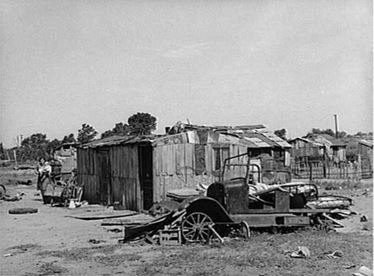Main Content
Lesson 2: The Development of Cinematic Language
The Realistic Home
There were small villages in Central Park, New York City filled with the very same type of shacks that Chaplin gives us in the film. Figure 2.21 is a picture of a squatter town in New York City which looks very much like the squatter town that Chaplin is rendering in the film.
Watch this clip of the Tramp leaving his home searching better conditions.
Video 2.30: Squatter home in Modern Times.

Chaplin shows the Tramp leaving his modest home in search of better material conditions, out of love. He enters the workforce again. He goes back to work at a factory. But again, we see the Tramp's inability to occupy the same space in the film as a machine without destroying them.
This is not what thwarts his plan to get a better house for his love interest. This time, the plans are thwarted by forces that are beyond his control. The factory, of course, is shut down by labor strike. This is a kind of irony that the people who are wanting to get back to work, the unions, shut it down almost immediately.
This is an introduction of an absurd ending to his attempt to find work in the industrial labor market, where he's the machinist's assistant. This essentially shows that Chaplin was ambivalent about unions, just as he was ambivalent about other features of industrial mechanized society. As is in all the other episodes, this episode ends up with the Tramp back in jail.
What we've seen each time is that when the Tramp tries to enter into the modern workforce, his incompatibility with modern forms of work, his need to play and to dream, in other words, to be very human, all of this forecloses integration into the society.
None of the jobs last long.
- The factory job lasts half a day.
- The dock job lasts five minutes.
- The night watchman job at the department store lasts one night.
- The mechanic's job lasts half a day.
The normative desire to hold down a job in modern society in pursuit of happiness, you might say, does not seem to fit with his free anarchistic spirit. Each segment ends with him back in jail. Every time he's unable to enter the modern world and be happy, Chaplin seems to be saying to us that humanity and the modern world don't go together.
It’s while he's in jail the final time that the gamine is discovered dancing to the music of a carnival. She gets a job as a dancer in a dance hall, and this opens up the possibility for the Tramp and the gamine earning a living in the one form of work that Chaplin seems to be saying values imagination and free spirit, which is entertainment. But, there we see that even art is commodified as the gamine's free dancing becomes something to be marketed by an entrepreneur.
